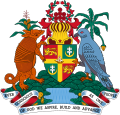This article needs additional citations for verification .(September 2023) |
Gouyave Gwouyav | |
|---|---|
Town | |
 | |
| Coordinates: 12°09′59″N61°43′48″W / 12.16639°N 61.73000°W | |
| Country | |
| Parish | Saint John |
| Government | |
| • MP | Kerryne James |
| Elevation | 269 ft (82 m) |
| Population (2008) | |
• Total | 3,378 |
| city proper | |
| Time zone | UTC-4 |
| Website | Official website |
Gouyave (Gwouyav) is the capital and largest town in the parish of St John, Grenada. It is located on the west coast of the island of Grenada.


